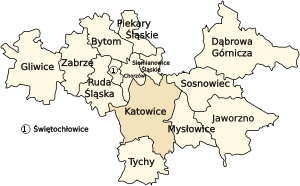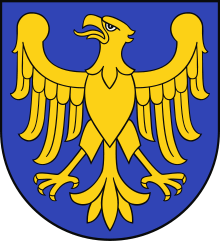Sosnowiec
| Sosnowiec | |||
|---|---|---|---|
|
Main square | |||
| |||
 Sosnowiec | |||
| Coordinates: 50°18′N 19°10′E / 50.300°N 19.167°E | |||
| Country | Poland | ||
| Voivodeship | Silesian | ||
| County | city county | ||
| Town rights | 1902 | ||
| Government | |||
| • Mayor | Arkadiusz Chęciński | ||
| Area | |||
| • City | 91.06 km2 (35.16 sq mi) | ||
| Elevation | 250 m (820 ft) | ||
| Population (2013) | |||
| • City | 214,488 | ||
| • Density | 2,400/km2 (6,100/sq mi) | ||
| • Urban | 2,746,000 | ||
| • Metro | 4,620,624 | ||
| Time zone | CET (UTC+1) | ||
| • Summer (DST) | CEST (UTC+2) | ||
| Postal code | 41-200 to 41-225 | ||
| Area code(s) | +48 32 | ||
| Car plates | SO | ||
| Website | http://www.sosnowiec.pl | ||
Sosnowiec ([sɔˈsnɔvʲɛt͡s]; German: Sosnowitz) is a city county in Zagłębie Dąbrowskie in southern Poland and also part of the Silesian Metropolis municipal association. Located in the eastern part of the Upper Silesian Industrial Region, it is one of the cities of the Katowice urban area – a 2.7-million-person conurbation – and within a greater Upper Silesian metropolitan area populated by about 5,294,000 people.[1] The population of the city is 220,450 (June 2009).[2]
Geography

Sosnowiec is the centre of the Zagłębie Dąbrowskie area within the historic Lesser Poland region near the border with Silesia. It is located about 10 km (6.2 mi) northeast of Katowice and 65 km (40 mi) northwest of Kraków, situated in the Silesian Upland on the rivers Brynica and Przemsza, a tributary of the Vistula. The city is part of Silesian Voivodeship since its formation in 1999. Previously (since 1945), it was part of Katowice Voivodeship, and before World War II, Sosnowiec belonged to Kielce Voivodeship.
Allegedly its name comes from Polish word sosna, referring to the pine forests which were common prior to 1830. It was originally known as Sosnowice. Other variations of the name include Sosnowietz, Sosnowitz, Sosnovitz (Yiddish), Sosnovyts, Sosnowyts, Sosnovytz, Sosnowytz, and Sosnovetz. There are five other smaller towns in Poland also called Sosnowiec, located in the regions of Kielce, Łódź, and Opole.
History

The history of Sosnowiec in the proper sense begins in 1902 when it was granted city rights by merging a number of settlements often several centuries old.
However, the history of the village of Sosnowiec dates back to the year 1227, when it was mentioned for the first time. It then was a small settlement in the Polish Duchy of Kraków, located in close vicinity of much larger and better developed villages of Sielce and Zagórze (both are now districts of the city). Other districts are even older. Milowice was first mentioned in 1123 as Miley. Documents from 1228 already mention Milowice, Klimontów, and Zagórze. Furthermore, Milowice was placed on a 1561 map.
As part of the Polish–Lithuanian Commonwealth, Sosnowiec belonged to Kraków Voivodeship, one of three voivodeships of Lesser Poland. It became a border town after the neighbouring Duchies of Silesia passed to the Bohemian Crown in 1335. In result of the Third partition of Poland in 1795, however, it was seized by the Kingdom of Prussia and was included into the newly established province of New Silesia. During the Napoleonic Wars, it became part of the Duchy of Warsaw in 1807 and later, of Congress Poland ruled by the namiestniks of the Russian Empire. Located at the borders with the German Empire and Austria-Hungary, Sosnowiec became famous for the Three Emperors' Corner tripoint, which was located within current limits of the city.
City rights

With effect from 10 June 1902, by the order of Tsar Nicholas II of Russia, Sosnowiec was legally named a city with the area of 19 square kilometres (7 sq mi) and with 60,000 inhabitants. Obtaining the city rights helped the dynamic economic and cultural development of the town. Apart from steelworks and coal-mines and many enterprises of heavy and light industry, new cultural and social establishments were opened as well. The newly established town consisted of the districts of Sosnowiec, Pogoń, Ostra Górka, Sielec, Kuźnica and Radocha, all of which had been separate villages before. The very fact that Russian authorities waited for so long to grant Sosnowiec town rights is seen as a consequence of the Polish January Uprising 1863/64, after which numerous towns had seen their status reduced to a village. Sosnowiec was first post-1860s location in Congress Poland to have received town charter, second was Puławy in 1906.
Natural resources and the good geographical location had an important influence on the development of Sosnowiec. The opening of a branch line of the Warsaw-Vienna Railway in 1859 was vitally important for the growth of the town. Development of industry with the new factory of rope and wire, rolling mill, steelworks, iron foundry, steam boilers factory, and later spinning mill, dye-house and paper mill sealed the new image of the town as entirely urban. The Summer Theatre and, in 1887, the Winter Theatre were founded, the second of which was called City Theatre from 1924 in independent Poland, and later the Theatre of Zagłębie. In 1914, the village of Środula was incorporated into Sosnowiec.
Second Polish Republic
In the Second Polish Republic, it was part of Kielce Voivodeship, and in 1934 the City County of Sosnowiec was established. Sosonowiec suffered war damages during both major military conflicts in the 20th century: World War I, which caused mainly destruction to industry, and World War II, which brought about the terror of executions.
After the 1939 Invasion of Poland, the city county was subordinated to German occupation by Wehrmacht forces and renamed Sosnowitz. Initially under military administration and part of the General Government, it was annexed and incorporated into the Province of Silesia on 20 November 1939. In June 1943 thousands of Jews were deported from Sosnowiec Ghetto to Auschwitz concentration camp. The ghetto was liquidated two months later and almost all remaining Jews (around 15,000) were also deported to Auschwitz. Previously there had been considerable underground activity among them. The Vistula–Oder Offensive of the Red Army in January 1945 brought about the liberation of the city, which gave it a chance for gradual rebuilding and further development.
Post-war
After World War II, Sosnowiec further developed. On June 1, 1975, the city was expanded, when such locations, as Zagórze, Kazimierz Górniczy, Porąbka, Klimontów and Maczki became its districts. Due to this fact, by 1977 the population of the city reached 200,000. Further growth was accelerated by the construction of Katowice Steelworks, and in 1981, the population of Sosnowiec was 250,000, reaching its peak in 1987, when it was 259,000. Since then, the population has been declining. In 1992, the city became seat of the Roman Catholic Diocese of Sosnowiec.
Economy
Sosnowiec is characterised by its urban dynamics, economic activity, and care for both, its cultural heritage and natural environment. In recent years, Sosnowiec was further transformed from an industrial center with mainly mining and heavy industries into a hub of trade and services. Nevertheless, it still operates several important coal mines, steel factories and other heavy industrial plants.
Its Special Economic Zone, established in Sosnowiec thanks to the efforts of local authorities, plays a major role in attracting new businesses into the area. As a result, several companies with Polish and foreign capital opened their businesses in the city. Sosnowiec City Office was awarded the ISO 9001 2001 quality certificate for its management system for providing services for the local community.
From 2006 a new trade center Expo Silesia began hosting numerous trade shows. Activities of Artistic and Literary Society of Zagłębie Dąbrowskie prove also that Sosnowiec as an industrial centre is not only a working class environment.
Districts
For Sosnowiec's 100th birthday, the downtown area was thoroughly rebuilt, to harmonise its architectural layout and give the city a more modern image. In 2004 Sosnowiec authorities and designers were awarded the Grand Prix for the rebuilding of the downtown area in a competition for the best public space in the Śląskie Provinces. This investment had been accompanied by a program designed to improve the esthetic qualities of the city, under which a comprehensive program for unifying the colors of the elevations, and advertisements entitled “rainbow city” were introduced. Among the city districts there are:
|
|
Points of interest
The city has a 17th-century castle known as the Sielecki Castle. Other tourist attractions include:
- Dietla Palace
- Schöena Palace and museum
- Katedra Wniebowzięcia NMP w Sosnowcu
- Wilhelma Palace
- Church St Tomasza
- Railway Station Sosnowiec Główny
- Railway Station Sosnowiec Maczki
- Huta Buczek
Education and Science

Sosnowiec is an academic centre with well-developed research and educational infrastructure on top of industry, services and trade. Its own institutions of higher learning include:
- The University of Silesia (schools of modern languages, natural science, technology and a language teacher training college)
- Faculty of Earth Science
- Faculty of Computer and Materials Science
- Faculty of Philology
- The Silesian Medical Academy,
- Faculty of Pharmacy
- The private School of Marketing and Management
- The Silesian University of Technology
- Faculty of Automatic Control, Electronics and Computer Science
- The private School of Ecology
Among general secondary level schools in Sosnowiec there are high-schools such as the II Liceum Ogólnokształcące im. Emilii Plater, III Liceum Ogólnokształcące im. B. Prusa, and IV Liceum Ogólnokształcące im. St. Staszica.
Sports
- Zagłębie Sosnowiec: men's football team; Polish Cup winner: 1962, 1963, 1977, 1978
- KP Polska Energia Sosnowiec - men's volleyball team playing in Polish Volleyball League (Polska Liga Siatkówki, PLS), 5th place in season 2003/2004.
- kks czarni sosnowiec (Ekstraliga).
Rivers
- Czarna Przemsza
- Biała Przemsza
- Brynica
- Bobrek
- Potok Zagórski
International relations
Twin towns — Sister cities
Sosnowiec is twinned with:
|
Notable residents
- Paula Kania (1992-) Women's professional tennis player
- Edward Gierek
- Jędrzej Giertych
- Paul Godwin
- Haim Hefer (1925-2012), Israeli songwriter, poet, and writer
- Jan Kiepura
- Bartlomiej Oles
- Marcin Oles
- Shlomo Chanoch Rabinowicz, fourth Rebbe of Radomsk[3]
- Włodzimierz Sedlak
- Vladek Spiegelman
- James Spigelman, former Chief Justice of NSW Supreme Court
- Władysław Szpilman
- Shlomo Sztencl, Rav, dayan, and rosh yeshiva of the city[4]
References
- Official web site of Sosnowiec
- Sosnowiec on an old photography (in Polish)
- Local weather in Sosnowiec, Weather.com
- Mapquest link to 6 towns in Poland called Sosnowiec
- Encarta map of Sosnowiec, Śląskie, Poland
- Pictures of Sosnowiec (in Polish)
- Jewish Community in Sosnowiec on Virtual Shtetl
- Yizkor book of Sosnowiec
- about Haim Hefer (1925-2012)(in Hebrew)
- Notes
| Wikimedia Commons has media related to Sosnowiec. |
- ↑ European Spatial Planning Observation Network (ESPON)
- ↑ Central Statistical Office, Warsaw 2009, "Population. Size and Structure by Territorial Division, as of June 30, 2009" (PDF). Retrieved 2009-12-31.
- ↑ Tannenbaum, Rabbi Gershon (7 April 2009). "Radomsker Rebbe's Yahrzeit". The Jewish Press. Retrieved 9 January 2012.
- ↑ Gashury, Me'ir Shymon (1974). The Book of Sosnowiec and the Surrounding Region in Zaglebie. 1. Tel Aviv: Sosnowiec Societies in Israel and the United States, France and other countries. p. 142.
Coordinates: 50°17′N 19°08′E / 50.283°N 19.133°E



